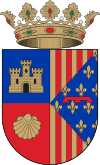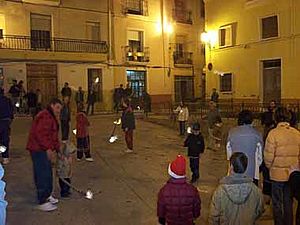Relleu facts for kids
Quick facts for kids
Relleu
|
|||
|---|---|---|---|
|
|||
| Country | |||
| Autonomous community | |||
| Province | Alicante | ||
| Region | Marina Baixa | ||
| Judicial district | Villajoyosa/La Vila Joiosa | ||
| Area | |||
| • Total | 76.87 km2 (29.68 sq mi) | ||
| Elevation | 429 m (1,407 ft) | ||
| Population
(2018)
|
|||
| • Total | 1,147 | ||
| Demonym(s) | Relleuer(a) (Valencian) Relleuero/a (Spanish) |
||
| Time zone | UTC+1 (CET) | ||
| • Summer (DST) | UTC+2 (CEST) | ||
| Postal code |
03578
|
||
| Official language(s) | Valencian, Spanish | ||
| Website | Relleu Town Hall | ||
Relleu is a small town in Spain. It's located in the Valencian Community, in the province of Alicante. Relleu is part of a region called Marina Baixa. The name "Relleu" means "relief" in the Valencian language. This name describes the town's hilly and mountainous surroundings.
Contents
Exploring Relleu's Geography
Relleu is in the middle of a valley. Tall mountains surround it, like the Cabeçó d'Or (1,209 meters high). Other mountains include the Serra de la Grana (1,095 m) and the Serra de l'Aguilar (895 m).
How to Get to Relleu
The easiest way to reach Relleu is from Villajoyosa/La Vila Joiosa. You can take the CV-770 road that connects to Orxeta-Sella. If you are coming from Alicante, you can use the AP-7 or N-332 roads. Then, take the CV-775 road from El Campello to Relleu.
Neighboring Towns
Relleu shares borders with several other towns. These include Aigües, Alicante/Alacant, Busot, Jijona/Xixona, Orxeta, Penàguila, Sella, and Torremanzanas/La Torre de les Maçanes.
Relleu's Rich History
Relleu has a long and interesting past. It goes back to the time of the Roman Empire. A doctor named Alejandro Sendra found a Roman burial stone here. This stone showed that Romans lived in the area a long time ago. More recent discoveries in the town are helping us learn even more about its history. During Roman times, Relleu was likely connected to the important Roman town of Villajoyosa/La Vila Joiosa.
Ancient Iberian Settlement
The history of Relleu is even older than the Romans. About 400 years before the Romans, there was an Iberian settlement. This ancient village was located on the highest point of the Penya-roja hill. A book called ‘Contestina Ibérica’ by E. Llobregat talks about this settlement.
Sadly, this old site has been disturbed over time. But you can still find thick walls and pieces of ancient amphora (large jars). There are also small bits of Iberian pottery and signs of iron working. These items, along with others in the local museum, suggest people lived here continuously. This was especially true during the 2nd and 1st centuries BC, when the Romans took control.
Relleu's Medieval Past
The town's name, Relleu, comes from the rugged land around it. High above the town are the ruins of an 11th-century castle. This castle was built by the Muslim people who lived here. In the past, Relleu had about 70 houses and was linked to Cocentaina.
After James I of Aragon conquered the region, Relleu became property of Bernat de Sarrià. For a long time, its church was part of the Finestrat parish.
Changes in Population
In the late 1500s, the Duke of Osuna owned Relleu. A big change happened in 1609. King Philip III ordered the expulsion of the Moors. Many people in Relleu, who were Moors, had to leave. Some fled to the mountains and fought back. Only about 15 Christian families remained in the town.
At the start of the 20th century, Relleu grew a lot. It had 3,342 people. This growth was because of irrigation from the Amadorio River. This water helped farms grow many crops. Today, the ruins of the old castle are protected by Spanish law.
People of Relleu: Demographics
Relleu's population changed a lot over time. In 1900, there were 3,342 people. By 1991, this number dropped to 717. Many people moved away to find work.
However, in recent years, Relleu has become popular with people from other countries. Many British citizens have moved there. This has helped the town's population grow again. In 2011, Relleu had 1,338 people. About 42% of them were from other countries. By 2018, this number changed to 38.3% foreign residents.
Population Changes Over Time
| Year | 1857 | 1887 | 1900 | 1910 | 1920 | 1930 | 1940 | 1950 | 1960 | 1970 | 1981 | 1991 | 2001 | 2006 | 2007 | 2009 | 2010 | 2011 | 2015 | 2019 |
|---|---|---|---|---|---|---|---|---|---|---|---|---|---|---|---|---|---|---|---|---|
| Population | 2,521 | 3,018 | 3,342 | 3,080 | 2,690 | 2,424 | 2,001 | 1,813 | 1,539 | 1,307 | 1,009 | 717 | 795 | 1,046 | 1,090 | 1,262 | 1,279 | 1,338 | 1,279 | 1,160 |
Foreign Residents in Relleu
This table shows how the number of foreign residents has increased since 2000.
| Year | 2000 | 2001 | 2002 | 2003 | 2004 | 2005 | 2006 | 2007 | 2008 | 2009 | 2010 | 2011 | 2018 |
|---|---|---|---|---|---|---|---|---|---|---|---|---|---|
| Natives | 760 | 741 | 737 | 725 | 725 | 749 | 741 | 720 | 763 | 758 | 752 | 775 | 707 |
| Foreigners | 35 | 54 | 84 | 131 | 200 | 273 | 305 | 370 | 442 | 504 | 527 | 563 | 440 |
Languages Spoken in Relleu
In Relleu, two languages are official: Valencian and Spanish. When you visit, you'll often see signs in Valencian and English. The town hall even has someone who speaks English to help visitors from other countries.
Relleu's Economy
Farming is still done in Relleu, especially growing almonds and olives. However, it's not as important as it used to be. Today, most of Relleu's money comes from services, like shops and tourism.
In 2008, Relleu had a very high number of registered cars. This was because the town hall offered a big tax discount for vehicles. This meant Relleu had more cars per person than any other town in Spain!
Cool Places to Visit in Relleu
Relleu has many interesting historical sites and beautiful spots.
Relleu Castle
This old castle was built by the Moors in the tenth century. Now, it's mostly ruins. In 2001, it was recognized as a place of "Special Cultural Interest."
Historic Buildings
- Casa Balde, La Garrofera. This building was listed as "Special Cultural Interest" in 1997.
- Torre de la Vallonga. This tower was also listed as "Special Cultural Interest" in 1997.
The Town Centre
Relleu's town center has narrow, winding streets. They are like the old markets found in Arab countries. The buildings are very well preserved and show interesting architecture. The Plaza of the Sacred Heart of Jesus is in the middle. It's a popular meeting spot for local people.
St. James Parish Church
This church was first built in the 1600s on an old Moorish cemetery. It was rebuilt in 1931. A few years later, during the Spanish Civil War, the church was damaged and had to be repaired again.
The church bells are very special. They are the oldest in the entire province! During the Civil War, some soldiers wanted to take the bells. The mayor, Don Francisco Carbonell i Climent, bravely stood up to them. He insisted they needed a permit to take the bells. Because of his courage, the bells stayed in Relleu.
| Name of Bell | Diameter | Weight | Year |
|---|---|---|---|
| Santa Bàrbara | 49 cm | 15 cwt (762 kg) | 1827 |
| Puríssima Concepció | 73 cm | 25 cwt (1,270 kg) | 1873 |
| Maria del Milagro y S.Jaime | 92 cm | 36 cwt (1,829 kg) | 1790 |
Chapel of St. Albert
This chapel is on a hill near the town center. If you climb up, you'll get amazing views of Relleu and the surrounding area.
Relleu Dam (Pantano/Pantà de Relleu)
On the edge of town, you'll find the Pantano/Pantà de Relleu. This is an 18th-century dam wall. It's 30 meters high and 10 meters thick. The people of Villajoyosa wanted this dam built. King Philip IV allowed its construction in 1653. Today, the dam is not used, but the river gorge around it is very impressive.
The 'Kick of St. James'
There's a rock with a footprint mark on it. People say it's the "Kick of St. James". They believe the Apostle James visited this area long ago.
The K-T Boundary
On the road to Torremanzanas, you can see something very special. It's called the K-T Boundary. This is a geological mark left by an asteroid that hit Earth. This event caused the K–T extinction event, which led to the dinosaurs dying out. It's one of the few places in the world where you can see this mark!
Fun Local Celebrations
Relleu has three main festivals, called Festes Majors in Valencian.
Festes Patronals
These festivals last for five days. They happen on the last weekend of September. People celebrate the Virgin of Miracles and Saints Cosme and Damian. The celebrations include religious events and fun activities. There's a paella cooking contest, correfoc (fire-runs), music, and fireworks.
Sant Albert
This festival also lasts for five days. It's held on the weekend closest to August 7th. People go on a pilgrimage to the saint's shrine. There are also sardines, paella, games, costume parades, and music.
Mare de Déu del Miracle
In 1710, Relleu had a very bad drought. Crops failed, and animals died. The men of Relleu, who usually didn't go to church, all went to pray for rain. Their prayers were answered, and the drought ended. On April 11th, people remember this miracle of the Mare de Déu del Miracle (Mother of God of the Miracle). They celebrate with flowers, dancing at night, and processions. This is mainly a religious festival.
Other Festivals
- Rodar les Aixames. This unique festival happens on Christmas Eve, December 24th. It's an old tradition where people light torches (called aixames) and spin them around. Mostly children parade through the streets with these spinning torches. It's a very old tradition that continues today.
- La Matança (Slaughter). This festival is on the weekend closest to January 17th, the day of St. Anthony. It remembers the time when people used to prepare their pigs for food. At the end, everyone can taste the meat, with music from the town's musicians.
- Concurs d'Alfàbegues (Basil contest). This is a newer festival, started in 2000. It happens two weeks before the Mare de Déu del Miracle festival. It's a way to encourage people to plant and care for plants. Prizes are given for the best plants.
Delicious Local Food
Relleu has some tasty local dishes.
- "Olleta de Blat" means 'big pot of wheat'. It's a stew made with beans, pork ribs, and black pudding.
- The "Borra" is made with spinach, cauliflower, sausages, and cod.
- "Faseura" is a dish with corn cakes.
- You can also try different types of "coques" (sweet or savory bread-based cakes). Some names are "Farcida", "Escaldà", or "a la Paleta".
Images for kids
See also
 In Spanish: Relleu para niños
In Spanish: Relleu para niños







